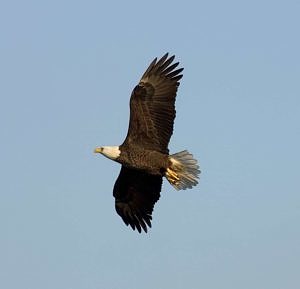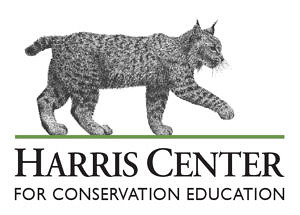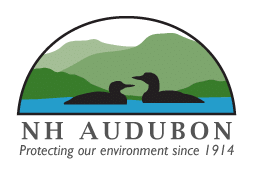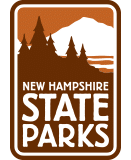Monitoring Migrating Raptors Since 2005
The Pack Monadnock Raptor Observatory regularly records more than 11,000 fall-migrating raptors each year — counts in 2014 exceeded 19,000! — making it one of the most productive hawk watch sites in northern New England. Read more below, or in our Hawk Watch brochure.
Location & Topography

A Bald Eagle soars on updrafts through a bluebird autumn sky. (photo © Lillian Stokes)
In order to conserve energy for the long journey to their wintering grounds in South and Central America, raptors soar on updrafts created by favorable winds and thermals produced by heat rising from the landscape below. (With the wind at their backs, many raptor species can travel distances of 250-300 miles in a single day!) It is this combination of geography and weather patterns that brings hawks to the Wapack Range: because of its high elevation (2,290′), location along a north-south ridgeline, and prominent views to the north and west, Pack Monadnock has long been known as an excellent vantage point for observing the hawk migration.
The Observatory is located in an expansive granite clearing on the north face of Pack Monadnock. It provides a stunning view of Mount Monadnock, as well as a scenic panorama of the Green Mountains (west), the White Mountains (north), and the coastal plain (east). On clear days, you can see Mount Washington.
Directions and location details — including information on parking, access, and accessibility — can be found here.
Migration
Biologists regularly record up to 15 different raptor species from Pack Monadnock during the fall migration. From mid-September through mid-October, significant daily and seasonal flights of Broad-winged Hawks, Sharp-shinned Hawks, Northern Goshawks, Peregrine Falcons, Ospreys, and Bald Eagles are possible. Mid-October through mid-November often brings Golden Eagles and Northern Goshawks.
The migration is most pronounced on northwest winds, especially on the several days following the passage of a cold front.
Site History
Although Pack Monadnock has been a popular spot for hawkwatching since the 1960s, it was not formalized as a site for migration research until 2005, when Iain MacLeod founded the Pack Monadnock Raptor Observatory for New Hampshire Audubon. New Hampshire Audubon provided full “raptor count” coverage by a seasonal field biologist every autumn from 2005 to 2017. In 2018, the Harris Center entered into a partnership with New Hampshire Audubon to ensure continued research and education staffing for the Observatory. In 2022, the Harris Center assumed full responsibility for Hawk Watch operations.
Project Partners
The Pack Monadnock Raptor Observatory is a project of the Harris Center, in partnership with the State of New Hampshire Department of Natural and Cultural Resources, Division of Parks and Recreation. It was founded by New Hampshire Audubon.
Contact Us
For more information on the Pack Monadnock Raptor Observatory or to volunteer, please contact Bird Conservation Director Phil Brown.





